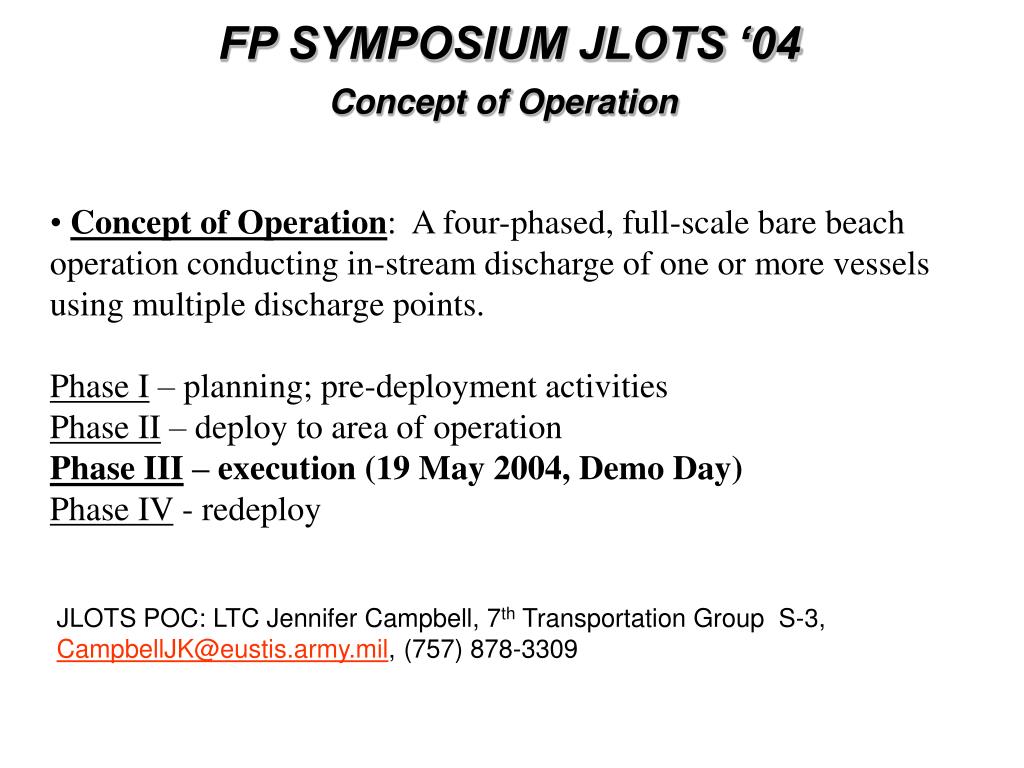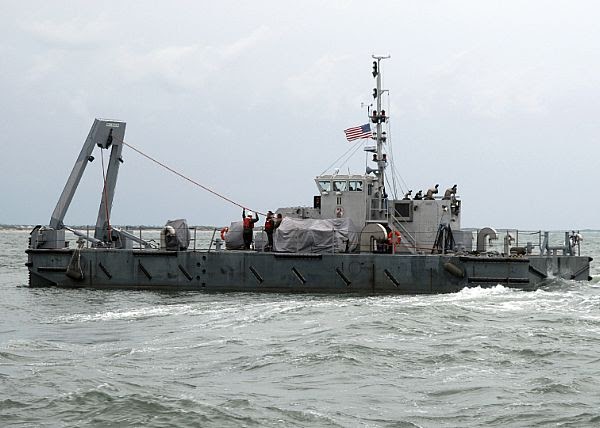Jlots Doctrine
[ILLUSTRATION OMITTED]
Doctrine must reflect the importance of JLOTS to emerging concepts such as seabasing to ensure seamless transition from one method of logistics delivery to another. Continued and expanded training opportunities will increase the breadth of JLOTS experience across all the Services. JLOTS PM5 BRIEF – A free PowerPoint PPT presentation (displayed as a Flash slide show) on PowerShow.com - id: 10b0c7-NzQ1Z. This publication sets forth joint doctrine and joint tactics, techniques, and procedures for conducting Joint Logistics Over The Shore (JLOTS) operations by the US Military Services during the conduct of joint operations. It provides basic doctrine concerning command relationships, responsibilities, and procedures for JLOTS operations.
The U.S. military conducts LOTS operations to load and unload ships through inadequate or damaged ports or over a bare beach when facilities are not available or are non-existent.
Joint Logistics Over-the-Shore occurs when Army and Navy units conduct LOTS operations together under one Joint commander in support of regional Combatant Commanders' exercise program. USTRANSCOM maintains oversight and DOD-wide governance of JLOTS as the Distribution Process Owner. USTRANSCOM JLOTS responsibilities include scheduling and assisting COCOMs to plan and execute JLOTS exercises, as well as oversight of JLOTS research and development, acquisition, training and doctrine.
As the Army's executive agent for JLOTS, SDDC's responsibilities include planning, execution, resourcing, guidance and training oversight for JLOTS exercises to improve Army power projection, force deployment, and logistics support to the warfighter.
SDDC is also responsible for the identification of resources to support the JLOTS program, and management of JLOTS funding and OSD service incremental funds. SDDC also reviews and provides guidance on preparation of field budget estimates for JLOTS exercises.
SDDC develops and implements a five-year JLOTS exercise program, and coordinates with force providers for identification and validation of forces, resources, and equipment for each exercise.
No portion of this article can be reproduced without the express written permission from the copyright holder.
Joint Logistics Over-The-Shore [JLOTS]
Joint Logistics Over-The-Shore [JLOTS] consists of loading / unloading of ships without fixed port facilities, in friendly or nondefended territory, and, in time of war, during phases of theater development in which there is no opposition by the enemy.
SECDEF included JLOTS program oversight responsibility in the USTRANSCOM Implementation Plan, and JCS further defined the JLOTS role in Joint Pub 4-01.2, (Sealift of Joint Forces) and Joint Pub 4-01.6, (JLOTS Operations).
Joint Logistics Over-The-Shore (JLOTS) provides required operational maneuver capabilities in areas of anti-access or area-denial and/or underdeveloped ports. Components provide equipment and train and exercise this capability to include at least one liquid-cargo and dry-cargo joint exercise per year. The Military Departments continue to evaluate interoperable technologies to provide this capability in environments greater than Sea State 2.
Although JLOTS will probably continue to play a large role in intra-theater movements and in supplementing other transportation systems, it does not appear that JLOTS can provide sufficient throughput quantities to meet the Objective Force guidance provided in the Future Combat System's (FCS) Statement of Required Capabilities.

The DPG calls for one liquid and one dry cargo JLOTS annually in conjunction with a JCS exercise. In FY95-99 USTRANSCOM worked with the geographical CINCS to schedule 2 separate JLOTS exercises - 1 liquid and 1 dry JLOTS annually. During FY00-05 USTRANSCOM worked to schedule one combined liquid & dry exercise annually to more closely simulate a contingency operation. TRANSCOM programs for JCS funding. The funding is to be used for strategic lift, port handling and inland transportation. The Services program for costs associated with unit participation.

By 1999 three out of the last four exercises were cancelled.
The first of these exercises was SOUTHCOM's FUERTES DEFENSAS in 1995. TRANSCOM rated it yellow based on a last minute recommendation from SOUTHCOM to shift the exercise location from Puerto Rico to Ft. Story, due to concerns over increased hurricane activity in the Caribbean. This change, occurring only one month before planned execution, required significant crisis action planning from USTRANSCOM, USACOM, and USSOUTHCOM. Additionally, high currents off Ft. Story significantly hampered discharge operations, resulting in only limited operational success.
In FY96, CENTCOM successfully executed a dry JLOTS integrated with BRIGHT STAR and ACOM successfully completed a liquid JLOTS in MARKET SQUARE.
In FY97, ACOM initially stated they would not conduct a JLOTS during that FY. After much negotiation at the G.O. level, they later reversed their decision and successfully planned and executed a dry JLOTS in support of JTFEX 97-2 off Ft. Story, Virginia. Also in FY97, PACOM completed their liquid JLOTS in support of FREEDOM BANNER in Australia. TRANSCOM rated this exercise as yellow based on the significant difficulty encountered transferring product from the Offshore Petroleum Discharge System (OPDS) to the Inland Petroleum Distribution System (IPDS). Inadequate interface between these two systems prevented successful pumping to the final destination.
Both of TRANSCOM's FY98 JLOTS exercises were cancelled. EUCOM's DYNAMIC MIX JLOTS was cancelled based on USAREUR's inability to support due to funding shortfalls. CENTCOM cancelled its liquid JLOTS associated with NATIVE FURY when it became heavily involved with a real world contingency in the Persian Gulf (DESERT THUNDER).
TRANSCOM's scheduled FY99 JLOTS exercises were PACOM's FOAL EAGLE and SOUTHCOM's BLUE ADVANCE. In an attempt to make up for lost training resulting from the NATIVE FURY Liquid JLOTS cancellation, TRANSCOM worked closely with PACOM and CFC to include liquid JLOTS operations in addition to the already planned dry JLOTS The dry JLOTS was conducted in Pusan to discharge elements of the 3rd Bde, 2ID. This was also a Combined JLOTS, with elements of the ROK Army's Port Operations Group working side by side with U.S. Army and Navy JLOTS forces. Liquid JLOTS was conducted in Pohang in conjunction with MPF discharge operations supporting related FREEDOM BANNER. Although somewhat limited in scope, this combined JLOTS was very successful.
Planning for a liquid JLOTS integrated with SOUTHCOM's BLUE ADVANCE proceeded relatively well. Unfortunately, increased political opposition after the Naval exercise held on the Island of Vieques, lead CINCLANTFLT to recommend and CINCSOUTH to approve, cancellation of this exercise. SOUTHCOM also declined to plan and execute an alternative exercise during the FY.
Exercise planners are not accomplishing long-term planning of the JLOTS portion of exercises. Typically, planning does not begin more than 12-18 months out from execution. This does not allow adequate definition of Service requirements far enough in advance for Services to program and fund resources. Additionally, major execution obstacles are often not discovered until late in the planning cycle, leaving inadequate time to resolve the issues or plan alternatives.
The size and scope of JLOTS exercises continue to be limited. This can be attributed to numerous factors, some of which include: budget reductions, OPTEMPO concerns, and decreased availability of exercise cargo.
The important challenge reflects the extent to which, no matter what initiatives are taken to improve the program, it cannot be successful without the full support of the warfighting CINCs. In times of tight budgets and OPTEMPO concerns, typically not all initial exercise objectives can be achieved with the limited forces and funds available. Inevitably, a cut line is established and lower priority objectives fall out. Funding for JLOTS continues to decline for both joint & service funds.
Turbo Patriot 2000 was the first U.S. Transportation Command-sponsored exercise specifically designed to test and evaluate the actual movement of forces and cargo in a joint-logistics- over-the-shore environment. The exercise entailed the real world movement of the 25th Infantry Division from Hawaii to the U.S. Marine Corps base at Camp Pendleton on the Southern California coast. MSC assets involved in this operation included USNS Seay and the Ready Reserve Force ships SS Cape Mohican, SS Chesapeake, and MV Grand Canyon State.

Lots Doctrine Definition
| Join the GlobalSecurity.org mailing list |